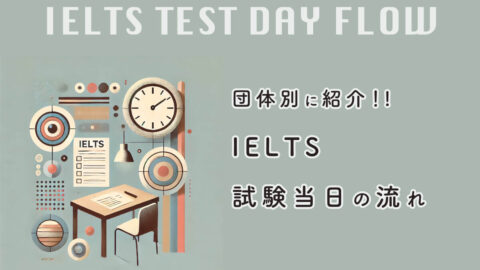こんにちは!
今回の記事では、IELTSリーディングで出題される問題形式の一つ「TRUE / FALSE / NOT GIVE 問題」の解き方を解説していきます。
練習用のリーディング問題も本記事の後半で紹介しているので、リーディング対策をしている方は参考にしてください。
「TRUE / FALSE / NOT GIVE 問題」はIELTS特有の問題形式で、NOT GIVEN と FALSE の判断が曖昧になることが多いので注意して読み解いてください!
目次:
TRUE / FALSE / NOT GIVEN 問題の解き方とコツ
TRUE / FALSE / NOT GIVEN 問題はIELTSリーディングの特徴的な問題の一つで、指示されるステートメントが本文と合っているかを判断する問題です。
指示文は、基本的に以下のような構成になっています。

また、TRUE / FALSE / NOT GIVEN と類似の問題形式で、「YES / NO / NOT GIVEN 問題」も出題されます。
いずれも、単に「合っている」「間違っている」の二択ならば簡単なのですが、「本文で言及されていない(Not Given)」という選択肢が含まれるため回答に時間がかかります。
スコアが5.5以下の場合は、思い切って全部 TRUE にしてもさほど正答率が変わらなかったりします。NOT GIVENを判断することに時間がかかるので、あえて時間短縮のためにこの問題形式は捨てるという判断をしてもいいかもしれません!
FalseとNot Givenの違い
True/False/Not Given問題では、
- TRUE(YES):本文で描写されている情報と一致している場合
- FALSE(NO):本文で描写されている情報と異なる場合
- NOT GIVEN:本文で言及されていない or 完全に肯定(否定)できない場合
という3つの観点のいずれかを、ステートメントと本文を照らし合わせて当てはめていきます。
FALSE と NOT GIVEN の違いは、「ステートメントを完全に否定することができるかどうか」という観点です。
例えば、以下の例題をみてみましょう。
- Environmental benefits
- Prior to the installation of the new electricity grid and renewable energy generation, most households on Eigg used diesel generators to supply electricity, resulting in significant carbon emissions. Homes were also poorly insulated and had old, inefficient oil-burning boilers, or used coal for heating.
- The work by the Eigg Heritage Trust to reduce energy use has resulted in significant reductions in carbon emissions from the island’s households and businesses. The average annual electricity use per household is just 2,160 kilowatt-hours (kWh), compared to a UK average in 2008 of 4,198 kWh. Domestic carbon emissions have fallen by 47 percent, from 8.4 to 4.45 tonnes per year. This compares to average UK household emissions of 5.5 to 6 tonnes per year. The emissions should fall even further over the next few years as the supply of wood for heating increases.
- Q. Wood will soon be the main source of heating on Eigg.
- 「木材はすぐにエッグ島の主な暖房の資源になるだろう」
という問題があったとします。
本文の最終段落で、
- The emissions should fall even further over the next few years as the supply of wood for heating increases.
- 「暖房用の木材の供給が増えるにつれて、排出量は今後数年間でさらに減少する」
とありますが、「Main Sourceになるかどうか」は本文からは判断できません
(Over the next few years という表現が will soon be の部分と違うということで FALSE にしないように気をつけましょう。あくまで設問の意図を正しく読み取ることが大切です。)
必ずしもYESともNOとも言えないステートメントなので、この問題の正解はNOT GIVENという考え方になります。
問題の解き方
True/False/Not Given問題は、基本的に以下の手順で解きます。
- 設問を確認する
- 設問に含まれるキーワードから本文の参照位置を探す
- 参照位置と設問を照らし合わせて情報を判断する
まずは、問題文を先読みして、ステートメントに含まれるキーワードを把握します。
基本的にキーワードは、本文で同じ意味の違う表現に置き換えられている(パラフレーズ)います。なので、類義表現に意識を向けながら、本文をスキャニングしていきましょう。
該当する部分が見つかったら、そのセンテンスと設問文を比較して情報が正しいかを判断します。くれぐれも、拡大解釈をしないように注意してください。
回答のコツ
回答する時は、以下のポイントを意識してください。
- 設問のキーワードを見つける
- キーワードのパラフレーズを本文から見つける
- 意訳して拡大解釈しないように気をつける
- 最初に設問全てに目を通さない
設問に含まれるキーワードとそのパラフレーズを探すことが、リーディングを解く上での最も基本的な解き方です。
また、問題を判断する時は必ず本文と照らし合わせて論拠を説明できるように心がけてください。感覚で解くと間違える確率が高くなります。
最後に、設問を読む時は最初の1問から順番に解いていきましょう。
一度に全ての設問を読み込んだとしても内容を覚えておくことが難しく、読み返す必要がでてくるので結局のところ時間をロスしてしまいます。
また、True/False/Not Given問題は設問の順番通りに本文に情報が載っているので、最初の1問目を解くことができればその後の問題をスムーズに解くことができるようになり時間を短縮することが可能です。
練習問題
解き方とコツがわかったところで、実際の問題を元に内容を確認してみましょう。
- India’s Modern Women
- (A)
- The country’s younger generation is shedding submissive attitudes, wants careers, and longs for wealth. And marketers are paying attention. When the first American music videos and popular TV shows began appearing in Indian homes in the early 1990s thanks to satellite and cable, many pundits predicted Indian society would never be the same. For the first time, female viewers saw independent, successful women and fun, sensitive guys. Sex and divorce were openly discussed in these TV imports and couples kissed passionately – then still a taboo in Indian TV shows and movies.
- (B)
- Indeed, the impact on younger generations of Indian women has been profound. Whereas Indian women traditionally have been submissive to parents and husbands and valued frugality and modesty, a number of sociological studies show that young Indian females now prize financial independence, freedom to decide when to marry and have children, and glamorous careers. A generation back, women would sacrifice themselves and believed in saving. Today, it is spend, spend, spend. It is OK for a woman to want something for herself, and people will accept it if she goes out into a man’s world making a statement.
- (C)
- Because today’s young women are the key consumer group of tomorrow, these shifts have big implications for marketing companies. And the trends come out clearly in two recent studies. One study examined 3,400 unmarried women aged 19-22 of different income and social levels. Altogether, the project involved 40 focus groups in five large urban areas and five smaller cities. In some cases, the researchers lived with the women for a while to study them more closely. The researchers supplemented this data with interviews of journalists, teachers, and psychologists.

解答と解説
練習問題の解説として、問のキーワードが、文章中でどのようにパラフレーズされていたか確認してみましょう。
ハイライトされている部分は、ステートメントのパラフレーズ部分を指しています。
Q1. FALSE
- 段落(A)の第三センテンスで「When the first American music videos and popular TV shows began appearing in Indian homes in the early 1990s thanks to satellite and cable, many pundits predicted Indian society would never be the same.」とあり放送されたことが確認できるので FALSEが正解。
Q2. FALSE
- 段落(B)の第二センテンスで「Whereas Indian women traditionally have been submissive to parents and husbands and valued frugality and modesty, a number of sociological studies show that young Indian females now prize financial independence, freedom to decide when to marry and have children, and glamorous careers.」とあり、「Perfection:典型」ではなく自由を目指したことが確認できるのでFALSEが正解。
Q3. TRUE
- 段落(C)の第五センテンスで「One study examined 3,400 unmarried women aged 19-22 of different income and social levels. Altogether, the project involved 40 focus groups in five large urban areas and five smaller cities. In some cases, the researchers lived with the women for a while to study them more closely. The researchers supplemented this data with interviews of journalists, teachers, and psychologists.」とあり、3つの異なる手法を用いてデータを収集していることが確認できるのでTRUEが正解。
以上が、IELTSリーディング「True / False / Not Given」の解き方の解説と練習問題の紹介でした。
まとめ
状況に応じて時間を使うべきかを判断する
今回の記事のポイントをまとめます。
- スコア5.5以下の場合は問題を飛ばすのも戦略としてあり
- FALSE と NOT GIVEN は設問を完全に否定できるかどうか
- 設問の意図を正しく読み取り感覚読みをできるだけ排除する
あくまで私個人の意見ですがスコアが低すぎる場合、TRUE / FALSE / NOT GIVEN 問題を飛ばしてしまう戦略も良いと考えています。
時間をかけすぎて全体の6割しか解けないよりも、9割解けている方が確実にスコアアップの可能性が高くなるので、まずは「全部の問題に回答できること」に焦点を当てた方が得策だと思います。
読解が楽になってきたら、徐々に「FALSE と NOT GIVEN の判断基準は何か」という指標を自分の中で納得いくように理解してみてください。
これらの違いを理解できるようになると、単にリーディングのスコアアップが見込めるだけでなく、ライティングの書き出し内容も相対的にレベルアップしますので。
FALSE と NOT GIVEN の判別は難易度が高く、スコア8.0以上取得できる人でも間違えることは珍しくありません。とにかく感覚で読むことをできるだけやめて、忠実に本文に書いている内容と情報を照らし合わせるようにしましょう!
次のレッスンでは、パラグラフ選択問題を扱います。
パラグラフの冒頭の1文のみならず、全体の流れを理解していないと誤答するように問いが作成されており、こちらも難易度が高い設問です。
最後に、IELTS対策で悩んでいることがあればお気軽にご連絡ください。












